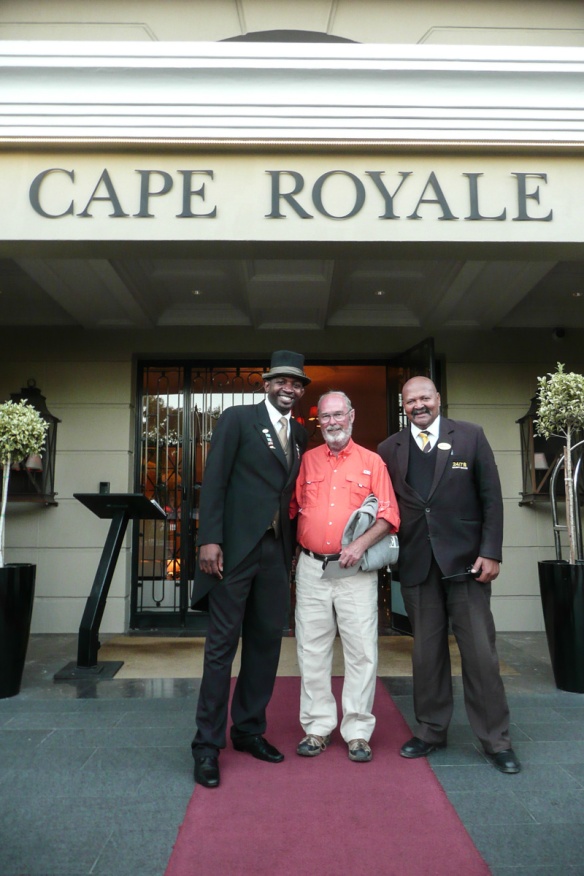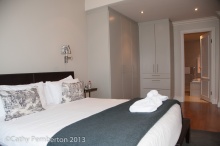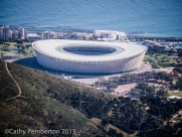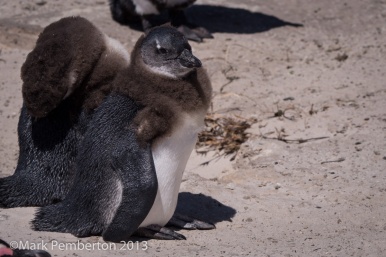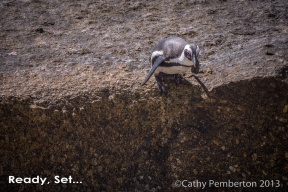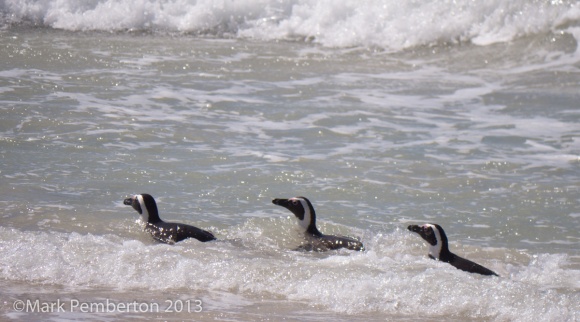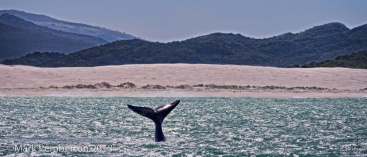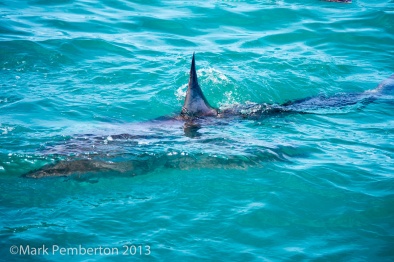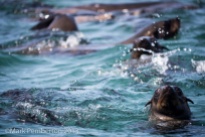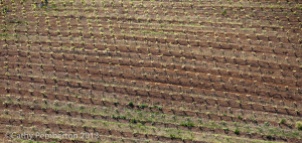We were all a bit sad to leave the bush behind and return to urban reality. We had seen so many beautiful animals; had so many great experiences; had so much fun! But truth be told, I was tired. Twelve days of bumping around rutted paths in a land rover had taken their toll.
We landed at Cape Town International Airport at about 8 pm and were met by Wayne Donaldson, who would be our host for the next 3 days. Wayne drove us from the airport to our hotel in downtown Cape Town, the Cape Royal. As we drove through Cape Town I was astonished at what a beautiful city it was. It was the complete antithesis of Johannesburg. It practically sparkled it was so clean and pretty. I admit that I knew virtually nothing about Cape Town prior to arriving and was stunned to find this jewel of Africa.
At our hotel we were met by doormen in tails and top hats. The word opulent is insufficient to describe the lobby. One of the door men asked me the name of our group, which I gave to him. Seconds later I was startled by the sound of a loud gong. The door man announced “Ladies and gentlemen, may I present Natural Exposures Photo Tours“, whereupon the entire staff in the lobby broke out in applause. Oh yeah, I knew I was going to like this place.
Click on any image to enlarge it. Hover over an image to view the caption (if any).
We were escorted to our rooms. They were clean, elegant and equipped with everything we could need. Our suite had two bedrooms and even a kitchen. And best of all, Tanya had arranged for a fruit and cheese plate to be delivered to everyone’s room. We devoured it.
Cape Town was originally established in 1652 by the Dutch East India Company. The Dutch used it as a replenishing stop on their way to the far east. Cape Town was the largest city in South Africa until the Witwatersrand Gold Rush of 1886 which resulted in the development of Johannesburg as the largest and most powerful city. Today Cape Town has a population of about 3.74 million people and is the most popular international tourist destination in all of Africa. Its popularity is due to the beautiful weather, spectacular beaches and other natural wonders such as Table Mountain National Park. Our hotel was just across the street from the Cape Town Stadium that was built for the 2010 FIFA Cup Football (soccer) Championships.
Table Mountain creates a bowl that Cape Town rests in and a majestic backdrop to the city. It now boasts the accolade of being one of the “New” 7 Wonders of Nature. The mountain top can be reached by aerial tramway or by hiking and provides spectacular views of the area as well as being host to numerous endangered or protected species of animals and plants.
On our first day in Cape Town we took a drive along the spectacular Chapman’s Peak Drive and saw some of the most incredible coast line imaginable. The water from the Atlantic was crystal blue. We approached the small town of Simon’s Town and the home of the African penguin at Boulders Beach. These funny little guys, also know as jackass penguins, are only about 2 ft tall and weigh 5 to 8 pounds. They arrived at Boulder beach in 1982 and since then the colony has increased to about 3000 individuals. What is amazing is that Boulder Beach is in the middle of a residential area! It was great fun to watch these little creatures waddle about and play in the water.
From Boulder Beach we made the drive down to the Cape of Good Hope. The Cape is not actually the southernmost point on the African continent but it is the most south western point. Cape Point a few miles away is actually the southern most point of land.
 It was extremely windy but we arrived just in time to see wave after wave of cormorants fly by. Their sleek black bodies standing out strongly against the crashing white surf. We also got close up and personal with the Rock Hyrax. These 9 lb. creatures most closely resemble the guinea pig but aren’t related. In fact, their closest living relative is the African elephant! They were running around everywhere. You had to be careful not to step on one.
It was extremely windy but we arrived just in time to see wave after wave of cormorants fly by. Their sleek black bodies standing out strongly against the crashing white surf. We also got close up and personal with the Rock Hyrax. These 9 lb. creatures most closely resemble the guinea pig but aren’t related. In fact, their closest living relative is the African elephant! They were running around everywhere. You had to be careful not to step on one.
As we were about to leave the Cape area Wayne spotted a Bontebok. The Bontebok is an endangered antelope that lives in the area. They were once considered to be a pest and slaughtered until the wild population was reduced to about 17 animals. Fortunately, with their protected status, their population has rebounded.
On our second day in Cape Town we headed for Gansbaai for a morning of whale watching. Gansbaai is noted for its population of Southern Right Whales. It is also the home of shark cage diving! While we were not going to go shark cage diving we were told that we would probably see one of the groups lowering their guests into the bay while the staff of the boat chums the water to attract sharks. But I digress…
The whale watching started off fine. We spotted several Southern Right Whales right away. However, the water was rough with some pretty big swells. That combined with the fact that we were in a pretty small boat made photography difficult as we rocked back and forth. The Southern Right Whale is a kind of gnarly looking whale. Most of the time I couldn’t tell what I was looking at. There were several breeches but Cathy and I observed only one.
Our captain spotted one of the shark diving operations and took us by for a look-see. There in a stainless steel cage, suspended from the side of the ship, were 5 people outfitted with wetsuits and masks. The people would submerge under water while the staff tried to attract sharks to the cage with lures and chum. And they were definitely succeeding as sharks came swimming right up to the divers.
From shark diving we headed off to an island populated with massive numbers of Cape Fur Seals. There were thousands of them everywhere. It made me think of what it must have been like when settlers first came to America and discovered the seemingly inexhaustible populations of wildlife. Unfortunately, as we have learned (or have we) time and time again, wildlife populations are not inexhaustible.
Wednesday, October 9th was to be our final day in South Africa. We started out with a tour of Table Mountain and then we headed out for a day of wine tasting. In the past 20 years South Africa has made quite a reputation for producing quality wines, and Wayne had lined up visits to two of the best. Our first stop was Druk My Niet where we toured the wine making facilities and then settled in to try a series of excellent wines. I was especially enamored with the Cabernet Franc.
Our second visit was to Kanonkop, described by those in the know as being the South African equivalent of a Premier Cru. Again we were served a stellar line up of wines while enjoying the relaxed atmosphere.
Our final stop for the day would be at Jordan’s for a late lunch. Jordan Wine Estate and Restaurant in Stellenbosch is renowned for its 6 course lunch and fabulous food. We only had time for two courses (and a visit to the cheese room) but it was superb. Situated on a large estate with a beautiful lake this was a perfect end to our adventures.
We made our way back to Cape Town to pick up our bags and then set off for the airport to catch our flight to London and then back to San Francisco. As we basked in the radiance of the past few days we were jarred back into reality on the drive to the airport. Despite all the progress that has been made in South Africa over the past 20 years, true equality is still an elusive goal, as the shanties on the outskirts of Cape Town demonstrate.
Our visit to South Africa was over but we brought home memories and photos to last a life time. To all of our old and new friends we say thank you for a magnificent expedition.

